Episodes
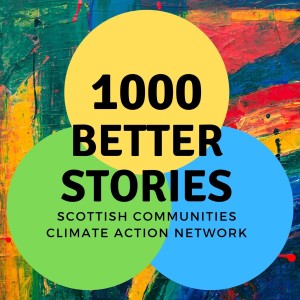
Monday Sep 02, 2024
Monday Sep 02, 2024
Our Story Weaver, Kaska, revisits Torry in Aberdeen for a GO Torry event, celebrating community's growing resilience in the wake of People's Assembly and its Declaration last Spring. We hear of RAAC and retrofit, outdoor classrooms and stealthy resistance, poetry and community with a heart.
Credits
Production: Kaska Hempel
Resources
1000 Better Stories podcast episode about Torry Peoples’ Assembly of May 2023 – putting “just” back into “just transition” https://www.podbean.com/eas/pb-5q33x-14be025
NEW! Torry Assembly website – with:
Tullos poetry zine from GO Torry event https://www.torryassembly.net/tullos-poetry-zine-1
Declaration of Torry Peoples’ Assembly 28th of May 2023 (PDF) https://www.torryassembly.net/s/Declaration-of-Torry-A6-booklet-v1-2.pdf
Updates on the retrofit project https://www.torryassembly.net/about-retrofit
Information about Torry Peoples Assemblies on the Grassroots to Global website https://www.grassroots2global.org/torry-peoples-assemblies
Communities Assembly training by Grassroots to Global, early 2024 – SCCAN video series https://youtube.com/playlist?list=PL727H-1nm_P25ueYx18ikvYroPMTGZ91-&si=dfN-nYxvbbaKQ3Ra
Just Transition Communities Project (NESCAN Hub) https://www.nescan.org/just-transition-communities
Station House Media Unit https://www.shmu.org.uk/
Friends of St Fittick’s Park https://saintfittickstorry.com/
Aberdeen Ethnic Minority Women’s Group https://www.abdn-emwomen.org.uk/
North East Scotland Mammal Network (FB group)
https://www.facebook.com/groups/335588875705435/
The Bridge Centre, Torry FB page https://www.facebook.com/thebridgecentretorry/
Social Juice https://www.social-juice-cic.co.uk/
St Fittick’s Park court appeal fails https://hellorayo.co.uk/greatest-hits/aberdeen/news/st-fitticks-lose-legal-challenge-over-park-development/
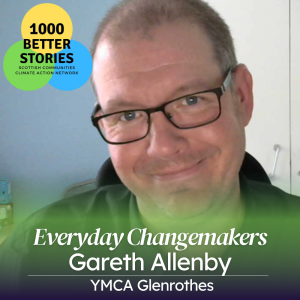
Monday Aug 12, 2024
Monday Aug 12, 2024
Our Story Weaver, Kaska Hempel, talks to Gareth Allenby from YMCA Glenrothes about weaving climate action into life journeys of young people experiencing homelessness and the joys of judging coleslaw competitions.
YMCA Glenrothes Healthy Living Garden project was one of the community groups that received a small community grant from the Fife Climate Action Hub last year. Apply for your grant here: https://fccan.org.uk/community-climate-grants/
Listen to our story about First Year of Fife Climate Action gathering https://scottishcommunitiesclimateactionnetwork.podbean.com/e/year-one-of-fife-climate-hub-deepening-the-network-for-action/
Transcript
See our website: https://sccan.scot/blog/everyday-changemakers-gareth-allenby-ymca-glenrothes/
Credits
Interview, recording and sound production: Kaska Hempel
Resources
Healthy Living Garden at YMCA Glenrothes https://www.ymca.scot/glenrothes/garden-open/
Sustainable Growing Event, Fife Climate Festival, at the Healthy Living Garden https://fccan.org.uk/events/ymca-glenrothes-fife-sustainable-growing-event/
Seed and Development Fund, Fife Climate Hub https://fccan.org.uk/community-climate-grants/
Climate Hubs Across Scotland https://sccan.scot/network-building/
Year One Of Fife Climate Hub - deepening the network for action (1000 Better Stories episode): https://scottishcommunitiesclimateactionnetwork.podbean.com/e/year-one-of-fife-climate-hub-deepening-the-network-for-action/

Monday Jul 29, 2024
Monday Jul 29, 2024
In this Edinburgh Fringe special, Kaska speaks to Lewis Coenen-Rowe about the trees and myths that inspired his deforestation opera STUMPED, becoming an artist activist, and about the importance of coming together for storytelling like this to help us imagine a better future and take collective action.
STUMPED is showing at the Scottish Storytelling Centre starting this week and each performance ends with a short reflection from a different invited expert or community group involved in caring for trees and forests.
Transcript
See our website: https://sccan.scot/blog/stumped-at-the-fringe-stories-trees-and-collective-action/
Credits
Interview and production: Kaska Hempel
Music: Exerpts from STUMPED by Lewis Coenen-Rowe, performed
Resources:
Lewis’ website https://www.lewiscoenen-rowe.com/
STUMPED opera on Insta https://www.instagram.com/stumpedopera/
STUMPED opera on FB https://www.facebook.com/profile.php?id=61557738514898&paipv=0&eav=AfZnr8aawmI-pzLrXUqtBT8rRZPKYyr8XH0MzRopZFZWSG8u_4NpXcaSEijReX9dubs
Made in Scotland Showcase https://www.madeinscotlandshowcase.com/
Creative Carbon Scotland https://www.creativecarbonscotland.com/
Scottish Storytelling Centre https://www.scottishstorytellingcentre.com/
Alliance for Scotland’s Rainforests https://savingscotlandsrainforest.org.uk/

Wednesday Jul 03, 2024
Wednesday Jul 03, 2024
Kaska Hempel reports from the Fife Climate Hub gathering in celebration of their first year. We hear how they have built on longstanding partnerships, welcomed new faces and the critical importance of leadership from governments in support of the urgently needed community climate action.
Consider this leadership when voting in general election on the 4th of July.
Reviews of party manifestos on environment:
Carbon Brief (Energy and climate only) - includes SNP and other minor parties
https://www.carbonbrief.org/uk-election-2024-what-the-manifestos-say-on-energy-and-climate-change/
Greenpeace and Friends of the Earth UK (energy and climate, nature and environment, homes and transport, justice and democracy) - only Conservatives, Labour, Lib Dems and Greens
https://friendsoftheearth.uk/system-change/general-election-2024-manifestos-final-scores
Credits
Recording and production Kaska Hempel
Music Victoria Hume, Oblivious Structures from Radical Abundance album. https://www.lostmap.com/products/victoria-hume-radical-abundance
Resources
FCCAN - Fife Climate Hub
https://fccan.org.uk/
River Eden Partnership
https://www.riveredenfife.org/
YMCA Healthy Living Garden
https://www.ymca.scot/glenrothes/garden-open/
St Andrews Botanic Gardens
https://www.standrewsbotanic.org/
The Curnie Clubs
https://www.facebook.com/FifeCurnieClubs/
Big Green Market
https://www.facebook.com/BurntislandGreenMarket
Climate Action Fife
https://www.climateactionfife.org.uk/
Fife Environment Partnership COP conference
https://www.fife.gov.uk/news/2023/fife-environmental-partnership-hosts-fife-climate-conference
Fife Environment Partnership
https://www.fife.gov.uk/kb/docs/articles/have-your-say2/community-planning
Paper Boats
https://paperboats.org/
Women’s climate action
https://womensclimateaction.net/
Kathleen Jamie’s poem What the Clyde Said After COP26
https://www.scottishpoetrylibrary.org.uk/poem/what-the-clyde-said-after-cop26/
SCVO Scotland
https://scvo.scot/
SCVO Growing Climate Confidence resources including Climate Scorecard for Socially focussed community organisations
https://climateconfident.scot/
Climate Cafe
https://www.climate.cafe/
Victoria Hume Radical Abundance
https://www.lostmap.com/products/victoria-hume-radical-abundance?utm_medium=order-details&utm_source=customer-accounts&utm_content=name
Oblivious Structures
https://www.youtube.com/watch?v=xmc8woJ6ppg
“Less is more how degrowth will save the world” by Jason Hickel
https://www.penguin.co.uk/books/441772/less-is-more-by-jason-hickel/9781786091215
Climate Outreach - Leadership on Climate
https://climateoutreach.org/britain-talks-climate/climate-big-picture-2024/leadership/
Climate hub stories on 1000 Better Stories channels:
Climate Action Hub Pilots - connecting local communities for change
https://www.podbean.com/eas/pb-kqdw6-12e1778
Edinburgh Communities Climate Action launch day (blog)
https://sccan.scot/blog/edinburgh-communities-climate-action-launch-day/
TsiMoray Connect the Dots conference (blog)
https://sccan.scot/blog/join-the-dots-tsimorays-annual-conference-connecting-ideas-people-moray/

Tuesday May 28, 2024
Tuesday May 28, 2024
Our Story Weaver, Kaska Hempel, talks to Rebecca Gibbs from SCCAN about rollerblading for sanity, turning NET zero into NOT zero and the invitation to get into climate adaptation planning with us.
Transcript
See our website: https://sccan.scot/blog/everyday-changemakers-rebecca-gibbs-sccan/(opens in a new tab)
Credits
Interview, recording and sound production: Kaska Hempel
Resources
Rebecca can be reached on rebecca@sccan.scot
NEW! SCCAN Adaptation for Communities resources and news
https://sccan.scot/climate-adaptation/
Storm Angus - contribute your stories of impacts of recent storms on Angus
https://www.angusclimatehub.co.uk/storm-angus
Climate Regional Networking Project
https://sccan.scot/network-building/
Cadence Roundtable
https://cadenceroundtable.org.uk/
Pollock Park
https://www.glasgow.gov.uk/article/4187/Pollok-Country-Park
Galgael Trust
https://www.galgael.org/
Not Zero - How net zero targets disguise climate inaction (Report PDF) https://whatnext.org/research_pubs/not-zero-how-net-zero-targets-disguise-climate-inaction/
Prof Kevin Anderson on Net Zero
-Short video: https://www.youtube.com/watch?v=pEk0uQ7nPV8
-In depth video: https://www.youtube.com/watch?v=LUwSNuHlve8&t=3s
Carbon Capture and Storage explainer from Juice Media
-(sweary version) https://www.youtube.com/watch?v=MSZgoFyuHC8&t=2s
-(PG version) https://youtu.be/ThnLghO3Pv8?si=EBXIgUAa8dKZ3ddf
Roller Stop https://rollerstop.co.uk/
Climate Psychology Alliance
https://www.climatepsychologyalliance.org/
National Consortium for Societal Resilience [UK+]: New Zealand Community Emergency Response Hubs
https://youtu.be/yNdF9kWG1A4?si=H1yg5xeJId8eAAhq
Adaptation Scotland Community Climate Adaptation Routemap https://www.adaptationscotland.org.uk/how-adapt/tools-and-resources/community-climate-adaptation-routemap
Flood Mary
https://floodmary.com/
Global Assembly
https://globalassembly.org/
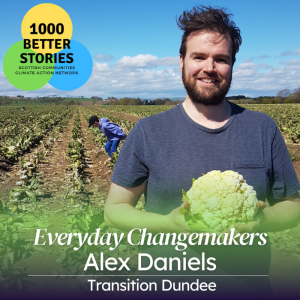
Wednesday May 15, 2024
Wednesday May 15, 2024
Our Story Weaver, Kaska Hempel, talks to Alex Daniels from Transition Dundee about gleaning, fair access to fresh food and his favourite glut-busting recipes.
Transcript
See our website: https://sccan.scot/blog/everyday-changemakers-alex-transition-dundee/
Credits
Interview, recording and sound production: Kaska Hempel
Resources
Register for 1000 Better Stories Collective skillshare with Manuela and Daniel from Maxwell Centre in Dundee, 30 May, 1-2pm
https://www.eventbrite.co.uk/e/904908354247
Gleaning Project at Transition Dundee
https://www.transitiondundee.com/gleaning
The Gleaning Network
https://gleaning.feedbackglobal.org/
West End Community Fridge
https://www.transitiondundee.com/community-fridge
Campy Growers
https://campygrowers.uk/
Kris Harbour off grid living
https://www.krisharbour.co.uk/
Transition St Andrews
https://transitionsta.org/
Roasted cauliflower dip
https://www.cookincanuck.com/roasted-cauliflower-dip-recipe-vegan/
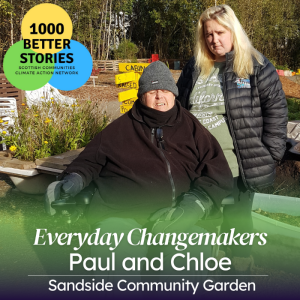
Wednesday Apr 17, 2024
Wednesday Apr 17, 2024
Our Story Weaver, Kaska Hempel, talks to Paul and Chloe about making dreams come true and turning the forgotten patch of land into a safe place for community connection and play.
The story is the last one in the five-part Dumfries series of Everyday Changemakers.
Transcript
See our website: https://sccan.scot/blog/everyday-changemakers-paul-and-chloe-sandside-community-garden/
Credits
Interview, recording and sound production: Kaska Hempel
Resources
Sandside Community Garden facebook page
https://www.facebook.com/sandsidegarden/
Gilbert’s coffee grounds composting project on Cycling Dumfries website
https://cyclingdumfries.wordpress.com/2023/06/12/trailer-tuesdays/
Scottish Government’s Adaptation Plan consultation, closes on 24th of April
https://www.adaptationscotland.org.uk/news-events/stories/scottish-national-adaptation-plan-public-consultation
Adaptation Scotland
https://www.adaptationscotland.org.uk/
Tenth consecutive monthly heat record alarms and confounds climate scientists, Jonathan Watts, The Guardian, 9 Apr, 2024
https://www.theguardian.com/global/2024/apr/09/tenth-consecutive-monthly-heat-record-alarms-confounds-climate-scientists?CMP=fb_gu&utm_medium=Social&utm_source=Facebook&fbclid=IwAR0Afp1lIWMzhzDZIChyxx0m-ji3_rgn-MtISK2lPJj0nTmB0MJ1i3qOZ6A#Echobox=1712642938
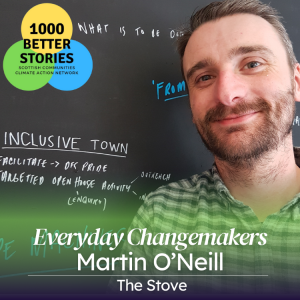
Monday Apr 08, 2024
Monday Apr 08, 2024
Our Story Weaver, Kaska Hempel, talks to Martin O’Neill from The Stove network about coming home and creative placemaking with his community.
The story is the fourth in a five-part Dumfries series of Everyday Changemakers.
Transcript
See our website: https://sccan.scot/blog/everyday-changemakers-martin-the-stove/
Credits
Interview, recording and sound production: Kaska Hempel
Resources
The Stove https://thestove.org/
Midsteeple Quarter stories and studies https://www.midsteeplequarter.org/midsteeple-quarter-resources
Newly published Creative Placemaking report based on the Stove’s work https://thestove.org/how-creativity-culture-can-support-communities/
What We Do Now creative placemaking network https://whatwedonow.scot/
Post-covid Open Hoose programme which launched 10 community-driven initiatives, including Climate Kitchen https://thestove.org/projects/ongoing-projects/open-hoose/
Dumfries Climate Kitchen https://climatekitchen.co.uk/
From our archive - another scottish example of community-driven town centre regeneration story 1000 Better Stories Podcast: Carolyn Powell, Huntly Development Trust https://www.podbean.com/eas/pb-6e2tu-142d6cf
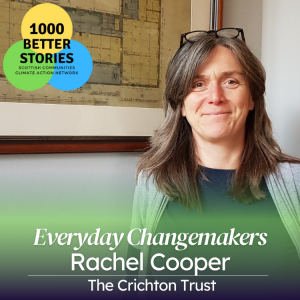
Wednesday Mar 20, 2024
Wednesday Mar 20, 2024
Our Story Weaver, Kaska Hempel, talks to Rachel Cooper of The Crichton Trust about taking large strides and small steps in their journey towards their zero carbon future teeming with life.
The story is the third in a five-part Dumfries series of Everyday Changemakers.
Transcript
See our website: https://sccan.scot/blog/everyday-changemakers-rachel-the-crichton-trust/
Credits
Interview, recording and sound production: Kaska Hempel
Resources
The Crichton Trust https://www.crichton.co.uk/
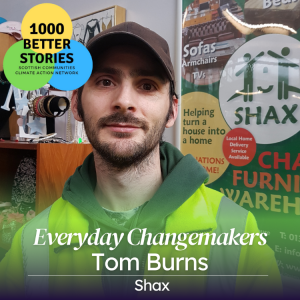
Monday Mar 11, 2024
Monday Mar 11, 2024
Our Story Weaver, Kaska Hempel, talks to Tom Burns, Marketing Officer from Shax, about the circular economy with a heart.
The story is the second in a five-part Dumfries series of Everyday Changemakers.
Transcript
See our website: https://sccan.scot/blog/everyday-changemakers-tom-burns-shax/
Credits
Interview, recording and sound production: Kaska Hempel
Resources
Shax https://shax.org.uk/
Circular Communities Scotland https://www.circularcommunities.scot/
Investing in Volunteers Award https://investinginvolunteers.co.uk/
Volunteer Friendly Award https://volunteerfriendly.co.uk
The Crichton Trust https://www.crichton.co.uk/


